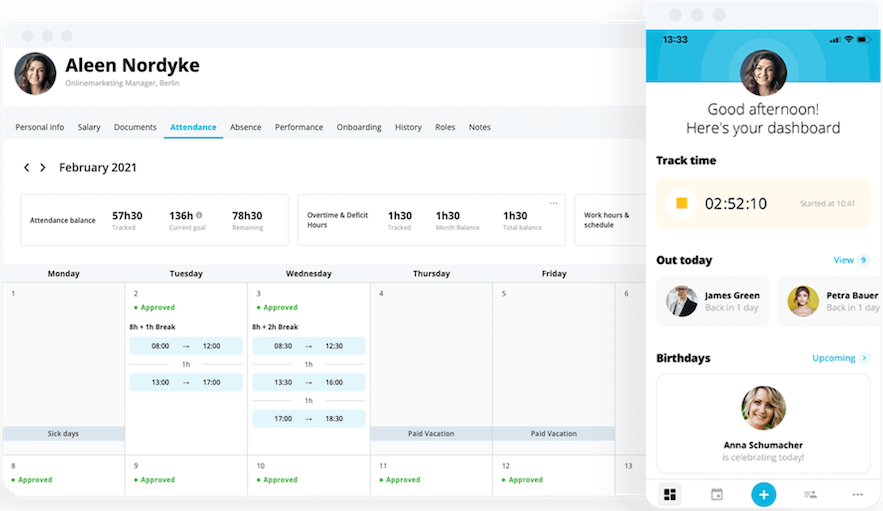
Download our free guide
Everything you could possibly need to know about corporate culture.
Download it todayWorkplace Wellbeing: Effectively Managing Wellbeing at Work
Workplace wellbeing isn’t just nice for employees – it could be crucial to the success of your business. Employees who are happy, healthy and engaged perform better than those who are tired, stressed and overworked.
They’re also less likely to leave for another job, and more likely to tell others that your organisation is a good place to work. Read on to learn what employers need to know about managing wellbeing at work.
Key facts:
Workplace wellbeing covers all aspects of how an employee is doing at work, including their physical, mental, emotional and even financial health.
There are many benefits to looking after your workforce’s health and wellbeing, including increased productivity, improved performance and reduced rates of absenteeism, presenteeism and attrition.
Workplace wellbeing initiatives will only be effective when they’re built into the company’s culture — not added as an afterthought.
Contents
- 1Workplace Wellbeing Defined
- 2Benefits of Wellbeing in the Workplace
- 3Roadblocks to Staff Wellbeing
- 4The Role of Managers, HR and Employees in Supporting Workplace Wellbeing
- 5How to Promote a Healthy Workplace
- 6Frequently Asked Questions About Workplace Wellbeing
- 7The Right Tools for a Healthy and Happy Workforce
Workplace Wellbeing Defined
Workplace wellbeing is a broad term that describes employees’ mental, physical, social and financial wellness. There are plenty of things that employers can do to improve their employees’ wellbeing — and there are some big benefits to doing so.
When you look after your employees’ wellbeing, they are likely to be happier, healthier and more motivated at work. From the employer’s perspective, that’s a good thing because it tends to mean that productivity and performance improve.
We’ll talk about some of the other benefits of workplace wellbeing below.
Benefits of Wellbeing in the Workplace
Here are some of the main benefits that workplace wellbeing can bring to both employees and employers:
Improved Productivity and Performance
Employees who are healthy, motivated and energised are much more likely to be productive and produce better work. That means that looking after your employees’ wellbeing isn’t just about being nice — it could also boost your bottom line.
Increased Talent Retention and Attraction
When employees know that their organisation supports their wellbeing, they’re less likely to look for work elsewhere. That means workplace wellbeing could reduce employee turnover, saving you money on recruitment, onboarding and training. Plus, making wellbeing a key part of your employer value proposition (EVP) could help you to attract talent.
Reduced Absenteeism and Illness
According to government data, 17 million days of work were lost in the UK in 2021/22 due to stress, depression and anxiety. That’s a lot of lost time — and much of it could probably have been avoided. Workplace wellbeing initiatives can help you to reduce sickness and absenteeism by working to reduce stress before it becomes a big problem.
Reduced Presenteeism
Presenteeism is when employees come to work even though they’re sick and unable to work productively. And, according to one study, it costs UK businesses £15.1 billion every year — almost double the cost of absenteeism. A focus on workplace wellbeing can help organisations to cut presenteeism by removing pressure on employees to show up even when they feel unwell. Ultimately, this means they’ll be able to recover more quickly, and won’t pass their illnesses along to their colleagues — leading to improved productivity in the long run.
Roadblocks to Staff Wellbeing
Here are some of the biggest roadblocks you might face when trying to introduce employee wellbeing initiatives in your workplace:
Getting Buy-In From Leadership
Workplace wellbeing initiatives shouldn’t be treated as an add-on or a nice-to-have extra — they should be baked into all of your organisation’s policies, procedures and decision-making processes. But getting senior leaders on board with wellbeing programmes can be challenging. Many of them are focused on the company’s core strategic objectives, and see these sorts of initiatives as a distraction.
Perceived Cost of Workplace Wellbeing Programmes
Many company leaders are reluctant to get behind wellbeing initiatives because of the cost they assume is involved. If they don’t see wellbeing as a priority, they are often reluctant to approve spending on these programmes. It’s important to stress to leadership that wellbeing initiatives don’t have to cost a fortune. In the long run, they can actually save a company money by reducing absences and attrition and increasing productivity and performance.
A Company Culture That Doesn’t Support Wellbeing
No matter what wellbeing initiatives you put in place, they won’t work if you don’t have a workplace culture that supports them. For example, in a culture where employees are constantly praised for ‘going above and beyond’ by working weekends and late nights, you’re likely to see higher rates of presenteeism. And any initiatives you develop to reduce stress won’t work if employees are struggling with huge workloads and feel pressured to get everything done.
A decade of insights on corporate culture

Download one of our latest People Manuals on the subject of corporate culture and become a subject matter expert today.
Download it todayThe Role of Managers, HR and Employees in Supporting Workplace Wellbeing
Managers, HR and employees all have a role to play in promoting wellbeing in the workplace.
To begin with, health and wellbeing initiatives are much more likely to be effective when they receive full support from the company’s leadership. Employees will realise that the organisation takes their wellbeing seriously when they see that it’s a key consideration even for senior leaders. Managers are also important role models, and seeing them actively participating in health and wellbeing programmes can encourage employees to get involved.
HR and people professionals are also crucial to the process of rolling out wellbeing initiatives. Since HR usually works with all areas of the business, they are in a good position to ensure health and wellbeing are built into the company’s policies and procedures at all levels. They can also work to ensure that wellbeing is treated as a priority in strategic discussions, and help to get leadership on board with wellbeing initiatives by explaining the benefits involved.
Lastly, employees are also responsible for looking after their own wellbeing. Employers and HR should encourage employees to get involved with any wellbeing programmes, and stress the importance of being healthy and happy at work. They should also seek employee feedback on their wellbeing initiatives so that they can make them as effective as possible.
How to Promote a Healthy Workplace
Want to start promoting a healthy workplace for your employees? Here are some tips to follow:
Build Wellness Into Your Company Culture
As we’ve said, workplace wellbeing shouldn’t be an afterthought — it should be baked right into your organisation’s culture. That means that every aspect of your culture should be built with your employees’ wellbeing in mind, from the hours you expect people to work to how you make decisions about promotions or pay rises.
Be Proactive, Not Reactive
Too many organisations only make health and wellbeing a priority once they realise they have a problem — like when their employee turnover goes through the roof, for example. In many cases, this means they don’t introduce wellness initiatives until it’s already too late. Instead of waiting until you have a problem, you should take active steps to reduce stress and help employees to make healthy decisions before things become problematic.
Provide Credit and Praise (For the Right Things)
Giving praise and recognition to employees can help them to feel recognised and appreciated at work. But it’s important to be strategic about who you’re giving praise to, and how you’re giving it.
The key is to shift the focus away from praising those who ‘go above and beyond’ (which can ultimately lead to burnout). Instead, give praise to those who do their work well while still taking the time to look after themselves and others.
Frequently Asked Questions About Workplace Wellbeing
Here are the answers to a few FAQs about workplace wellbeing initiatives and how they work.
What Is Workplace Wellbeing?
Workplace wellbeing is when employees feel physically, mentally and emotionally well in the workplace. There are many things that employers can do to improve their employees’ wellbeing, from making changes to the company culture to giving employees access to apps and other tools to look after their mental health.
Why Is It Difficult to Achieve Wellbeing in the Workplace?
There are a number of factors that can make it tricky for employers to support their employees’ wellbeing. First, HR and people teams might have a hard time convincing the company’s leadership that employee wellbeing is worth the investment. Some organisations also struggle to get employees fully on board with wellbeing initiatives, which can make them less effective. Lastly, an unhealthy corporate culture can make it difficult to achieve workplace wellbeing.
How Can HR Promote Wellbeing in the Workplace?
HR should work with employees to find out which workplace wellbeing initiatives they would find valuable. They should also regularly survey employees about the services they’re providing. Above all, HR should work with other departments to ensure wellbeing is built into the organisation’s culture, ways of operating and decision-making processes.
The Right Tools for a Healthy and Happy Workforce
HR teams are in a perfect position to help their organisations improve wellbeing at work. They often work with key stakeholders across the organisation, and can use their influence to ensure that health and wellbeing remains a key focus for everyone.
The problem is, HR teams often find themselves tied up with repetitive, administrative tasks — and don’t have much time for introducing new organisation-wide initiatives.
Enter Personio: the HR system that takes a whole range of tasks off your team’s already overflowing plates, so you can get back to taking care of your workforce. Personio lets you automate, streamline and simplify everything from applicant sourcing and absence management to performance and payroll.
Want to find out more? Book your free web demo to see Personio in action or start your free 14-day trial today.
